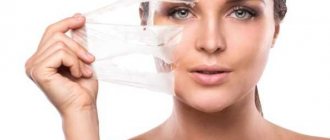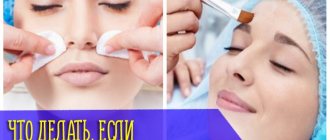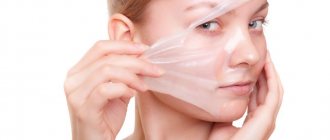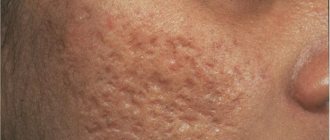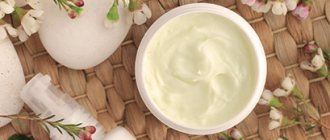Procedures associated with deep facial cleansing and rejuvenation have a recovery period, which is characterized by a number of unpleasant symptoms. In this article we will tell you how to properly care for your face after procedures, how to make the adaptation more comfortable and quickly “go out into the public eye” with renewed, radiantly beautiful skin.
Medium skin peeling
Medium peels are used for skin rejuvenation, because... actively stimulate the production of collagen in the dermis, as well as to combat hyperpigmentation.
Among the most popular: Jessner peel and its modifications, TCA (trichloroacetic peels), retinol/retinoic (also called “yellow peel”).
Medium peeling affects the entire stratum corneum and part of the epidermis. The most likely post-peeling consequences : the occurrence of erythema, the skin will peel, and during the procedure the occurrence of unpleasant sensations in the form of a burning sensation, sometimes accompanied by swelling. All this is normal , and usually the degree of manifestation depends on the number of layers that are applied during the procedure and how deeply the skin is affected!
Sometimes the post-peeling period is accompanied by pustular rashes, which indicates improper preparation of the skin.
Medium peeling is excluded for skin with hypersensitivity.
Healing takes 7 days, during which noticeable peeling, redness and some swelling of the skin are noted. This type of peeling procedure requires the strictest adherence to post-peel care instructions:
Cleanser
If skin barriers are damaged, the cleanser should not foam and contain aggressive surfactants. Only special preparations for delicate and sensitive skin are recommended, in the form of milk, with an oil base.
Example : DermaQuest Cleansing Milk for Delicate Skin is a cleansing milk based on valuable Shea and Jojoba oils with a cream texture. Removes all impurities while restoring damaged barriers of delicate and sensitive skin. Instantly gives skin softness and comfort.
To remove impurities, it is recommended to apply to dry or slightly damp skin, gently massage and remove with a damp cloth.
Protective cream with SPF30
To avoid possible and frequent complications in the form of dark age spots, creams containing physical factors that protect the skin (photo filters) from sunlight are regularly used.
These products are recommended to be used throughout the entire post-peeling period from the moment peeling appears until the integrity of the epidermis is completely restored, regardless of: time of year, sensitivity to the sun/ultraviolet.
Particles of physical (mineral SPF) mechanically protect the skin from rays and remain on the skin throughout the day.
Oil-based serums and creams
They are used to maintain the elasticity of the film formed on the face after peeling and to prevent it from cracking during the first days after the procedure. Maintains a crust, which retains moisture in the tissues to improve regeneration.
Healing and restorative products
When peeling occurs, it is necessary to include in your care products: with a healing effect (based on panthenol and royal jelly) and a restorative effect. Prescribe 2-4 applications per day or as needed to eliminate the feeling of skin tightness.
Lightening agents
Prescribed when working with pigmentation, or if there is a tendency to form it, in order to inhibit the hyperproduction of melanin in response to skin trauma.
It is important to strictly select the product, carefully studying its composition! The drug should not have an irritating or aggressive effect on the skin. Excluded: acids, retinol and hydroquinone .
Myths about post-peeling care: what you definitely shouldn’t do
There are many myths about skin care. Some of them can be dangerous even for completely healthy skin.
And after peeling, the skin is irritated and vulnerable, so you should take care of it even more carefully. Therefore, it is important not to be fooled by popular advice, and to know why they are harmful.
One of the most persistent myths is the myth about water with lemon; supposedly you need to wipe your face with water in which natural lemon juice is dissolved a week before the procedure. This is a dangerous misconception!
Lemon juice, even diluted in water, contains citric acid, which can disrupt the pH of the skin, causing irritation and even burns .
Citric acid in cosmetics is strictly controlled by the manufacturer, but home remedies containing it can be harmful.
A similar effect is caused by fresh fruit juice, which lovers of traditional medicine recommend for washing before peeling.
Peeling is a serious procedure, and there is no point in exfoliating the skin again if you are going to have professional exfoliation with products with proven effectiveness.
Superficial-medium peeling
This type of peeling involves the presence of slight peeling, affecting the stratum corneum with minimal penetration of part of the epidermis, and has a milder effect than the average.
The necessary medications for home care are the same as for superficial peeling (see below), however, additional emphasis is placed on:
Regenerating agents
Preparations capable of restoring deep skin barriers (DSE) to restore and protect the skin, as well as to prevent dehydration. These products contain ceramides, Omega 3 and 6 fatty acids, vegetable oils and others. They should be used 2-3 times a day, after cleansing and additionally if the skin feels dry and tight.
Example: Moisturizing cream for delicate skin, daily care DermaQuest - a cream based on valuable Argan, Jojoba, Rosehip oils, antioxidants and moisturizing complexes - instantly softens, moisturizes and creates a soothing barrier for sensitive skin. Relieves irritation and redness.
What's better
It’s quite difficult to say which is better - peeling or scrub? After all, it is necessary to take into account various aspects of the procedures. In terms of effectiveness, of course, it is more advisable to use not superficial, but medium and deep peeling, carried out in salons.
If you contact a competent cosmetologist, he will help you choose a special product taking into account the problems of your dermis.
At home, you can alternate superficial peeling with a scrub, or try doing joint cleansing to improve the effect.
If you first cleanse the skin of keratinized scales, and then start cleaning again with peeling gel, you can achieve a double effect, because the exfoliation product will be able to penetrate deeper into the epidermis, destroying the connections between the remaining dead cells and living ones.
Superficial skin peeling
Peeling, in which peeling occurs within the stratum corneum of the epidermis and is often not even noticeable to the eye. Peels are carried out once every 7-10 days.
The most popular group of peelings.
- Used for a number of indications : correction of age-related changes (all manifestations of aging, including wrinkles, loss of skin elasticity, etc.), acne, skin with increased oil content, to even out skin tone with hyperpigmentation.
- Superficial peels include AHA-based peels (containing glycolic, lactic, and mandelic acids). The concentration of acids may be different, but they do not penetrate deeply, while actively stimulating cell renewal.
- They are most popular because... effectively combat imperfections, while having a minimal risk of complications and a comfortable rehabilitation period. It will take 5-7 days for the skin to recover.
Protective cream with SPF
Be sure to use sunscreen for 3-7 days during the daytime.
Delicate cleansing
It is selected according to your skin type; it is not necessarily an oil-based product in the form of milk, as with medium peeling. However, it is worth excluding products based on aggressive surfactants with abundant foam formation.
Example : Facial cleansing gel, daily care DermaQuest - enzyme-based cleansing gel for all skin types: quickly removes makeup and impurities, can be used around the eyes. Leaves behind a feeling of cleanliness, hydration and comfort.
Products that restore skin barrier functions
Preparations that have a moisturizing, restorative and anti-inflammatory effect. These can be masks, serums and creams, selected according to your skin type and existing problems.
Choose products enriched with antioxidants to eliminate free radical reactions that inhibit the skin restoration process and can provoke pigmentation.
Active serum for the problem
Superficial peels are minimally aggressive and their effectiveness can be increased by using active serums for the existing skin problem.
Lightening agents
Prescribed if peeling was performed for the problem of age spots. The peeling procedure must be carried out under the cover of 3 types of drugs: antioxidants, lightening agents that block the hyperactivity of melanocytes and products containing photo filters (SPF). It should be remembered that all three types of products must be present in both pre- and post-peel care.
Example: Lightening cream "SkinBright" DermaQuest - lightens age spots, restores and intensively moisturizes, giving the skin a perfectly even tone and radiance. Contains Snow White Lily stem cells, peptides, antioxidants. Does NOT contain hydroquinone or AHA!
Complications
If peeling is carried out by a qualified cosmetologist, complications mainly occur only in the form of minor skin discomfort. But since the procedure is quite aggressive and the skin reaction is difficult to predict, the following consequences may occur:
- exfoliation of the skin;
- redness for more than 3 weeks;
- formation of pigment spots;
- the appearance of scars;
- swelling of the skin.
The occurrence of such complications requires contacting a specialist and prescribing additional care products. If this is not possible, pharmaceutical drugs can become an emergency aid. The most popular and effective cream is Bapanten 5%. It has a wound-healing, anti-inflammatory effect. It should be applied in such an amount as to prevent the skin from drying out.
How to peel your skin effectively and safely
Modern cosmetology users require the most effective products that do not cause skin side effects and restorative procedures, because There is no time to recover and exclude communication (even online).
Classic peelings are effective due to exfoliation and traumatization of the skin - the more peeling, the more pronounced the result.
When choosing a peeling procedure, choose Atraumatic enriched peels , which do not require such strict adherence to recommendations. They help improve the condition of the skin in the safest possible way and allow you not to fall out of the usual rhythm of life (work, sports, communication with people).
Modern atraumatic peelings are a light solution of acids (AHA and/or BHA) and provide light superficial exfoliation. They work due to active ingredients introduced into the peeling solution for skin problems.
Benefits of enriched peelings:
- Does not require rigorous preparation
- Off-season
- Without redness, peeling and irritation of the skin
- Highly effective (comparable to average)
- Possibility of individual selection
Examples: The professional brand DermaQuest provides specialists with a wide range of enriched peels for various problems.
For example, Peptide Peeling - with Botox effect, Pumpkin Peeling - Atraumatic skin cleansing, MangoBright Peeling - against diffuse pigmentation and many others.
Execution Sequence
As you know, peeling with acids is quite traumatic, so during sessions you wait 14–21 days so that the skin can recover. If your dermis tolerates exfoliation well, can you try combining peeling with scrubbing? Of course, yes, but only when you do superficial exfoliation.
Stages of combined use:
- Steam your face, which will help open the pores.
- They start with a scrub. The face is washed with baby soap, and then a scrub is applied and a light massage is performed, avoiding the area around the eyes. After 2 minutes, wash off the product with warm water or wipe with a napkin.
- Gentle cosmetics are applied to the skin for superficial peeling (in no case with strong chemical peeling!). Wait a few minutes (the manufacturer always indicates the holding time on the packaging).
- If the scrub can be wiped off with a regular napkin, then the peeling suspension is washed off with plenty of water or soda solution.
Cosmetologist Rene Rouleau advises alternating both procedures, after consulting with a specialist. For example, on Wednesday and Saturday you can treat your skin with scrubbing in the shower, and on Monday treat it with a superficial peeling agent.
Important point: Scrubbing after deep chemical peeling is prohibited, because the skin has been burned. Your dermis should recover in 14–21 days. As soon as you see that the condition of the skin has returned to normal (at least a month after the session), you can start using scrubs at home.
Thus, what to choose: peeling or scrub is up to you. But if you really want to not only cleanse your pores, but also improve the condition of your dermis, make an appointment with a cosmetologist for chemical peeling. Although this procedure is not the cheapest, and has a number of contraindications, it not only removes dead skin cells, but also normalizes the functioning of the sebaceous glands, eliminates acne and minimizes wrinkles. If going to a specialist is alien to you, it is recommended to combine superficial peeling with scrubbing at home to enhance the cleansing effect.
Other peelings
Types of peelings include:
- Laser peels , in the case of hardware laser peels, skin restoration depends, as with acid peels, on the depth of grinding and exfoliation of the skin. That is, rehabilitation is determined by the intensity of the laser effect on the skin.
- Scrubs are rarely used in salon treatments as an independent procedure. However, it is important which components (exfoliating particles) are included in the scrub. Typically, regeneration proceeds comfortably, and care corresponds to that for superficial peelings.
- Enzyme peelings. Considered the weakest and most atraumatic, they are sometimes performed before the chemical peeling procedure in order to prepare it for deeper penetration of acids in subsequent stages. And also for contraindications to chemical peels. No special care is required after enzyme peels.
Some basic tips
How to care for your face after peeling is usually told by the specialist who carries out the procedure. But you should also listen to some basic advice:
- create a care program taking into account the time required for recovery;
- thoroughly cleanse the skin of the face;
- provide hydration;
- develop measures to protect against the negative influence of the external environment.
It is worth examining each stage in more detail.

